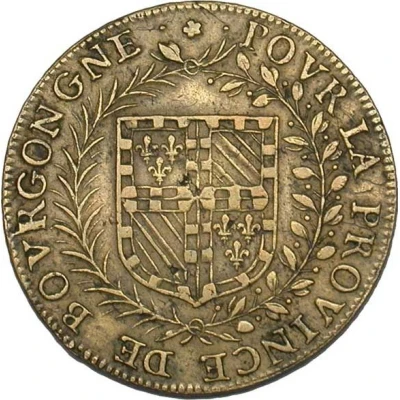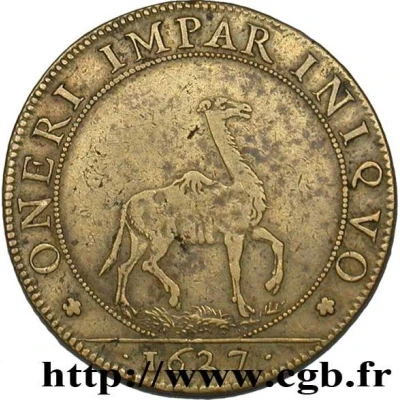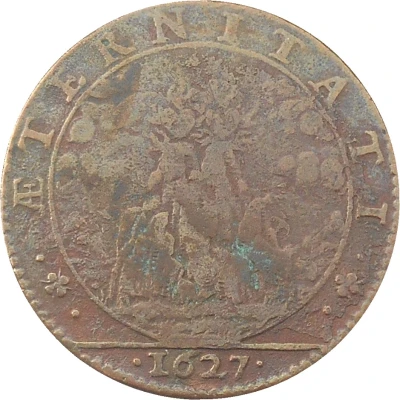Reverse
A lighthouse in the middle of the sea. On the right, the shore; on the left, a ship under sail.
Script: Latin
Lettering:
TERRAM. PERLVSTRAT. ET. VNDAS.
1627
Edge
Plain
Comment
In the Middle Ages, the King deliberated on important matters with the Court, made up of the great feudatories and ecclesiastical dignitaries. From this feudal Court of the King (the "curia regis"), several institutions gradually emerged, including the Parlement and the Chambre des Comptes in the 14th century, and then, under Louis XI, the Grand Conseil, whose members are chosen by the King. The role of the King's advisor, sitting on this council, was not limited to simple management assistance, but implied real participation in the kingdom's affairs. Over the course of the 14th and 15th centuries, this "Grand Council" became THE governing council in charge of political, administrative, financial and judicial affairs. It was made up of princes of the blood and peers, grand officers of the Crown and high dignitaries of the Kingdom chosen by the King. In 1497, a judicial section was detached from it and renamed the Grand Council, responsible for judging ecclesiastical affairs and jurisdictional disputes between the sovereign courts. In the 16th century, the complexity of affairs forced the sovereigns to divide the King's Council into specialized sections: the Conseil des Affaires for political matters; the Conseil des Parties (or Conseil privé) for current affairs of justice and administration; and the Conseil d'État for the most important affairs of the Interior and Exterior. It wasn't until the reign of Louis XIV that the King's Council was established in the form it remained until the end of the Ancien Régime, i.e., divided into four sections: The Conseil d'En-Haut (or Conseil d'État), which met two or three times a week with the King and the Ministers of State to deal with the Kingdom's most important affairs; the Conseil des Dépêches, for internal affairs; the Conseil des Finances, presided over by the King and including the Contrôleur général des Finances (for questions relating to the budget, the distribution of the taille, etc.); the Conseil d'État privé (or Conseil d'État privé), which met two or three times a week with the King and the Ministers of State to deal with the Kingdom's most important affairs.); the Conseil d'État privé, finances et directions, chaired by the King or the Chancellor and comprising some 30 conseillers d'État and 80 maîtres de requêtes, to settle private litigation, prepare the King's edicts and ordinances, investigate financial matters and settle administrative litigation.
This is an automatic translation. The original text is:
Au Moyen-Âge, le Roi délibère des affaires importantes avec la Cour, composée des grands feudataires et dignitaires ecclésiastiques. De cette Cour du Roi féodale (la "curia regis") se détachent progressivement plusieurs institutions parmi lesquelles le Parlement et la Chambre des comptes, au XIVème siècle, puis, sous Louis XI, le Grand Conseil, dont les membres sont choisis par le Roi. Le rôle de conseiller du Roi, siégeant en ce conseil, ne se limite pas à une aide simple en matière de gestion, mais implique une véritable participation dans les affaires du royaume. Au cours des XIVème et XVème siècles, ce "Grand Conseil" devient LE Conseil de gouvernement chargé des affaires politiques, administratives, financières et judiciaires. Il est composé des princes du sang et pairs, des grands officiers de la Couronne et de hauts dignitaires du Royaume choisis par le Roi. En 1497, une section judiciaire s'en détache et prend le nom de Grand Conseil, chargé de juger des affaires ecclésiastiques et les conflits de juridiction entre les cours souveraines. Au XVIème siècle, la complexité des affaires contraint les souverains à partager le Conseil du Roi en sections spécialisées : le Conseil des Affaires pour les questions politiques ; le Conseil des Parties (ou Conseil privé) pour les affaires courantes de justice et d'administration ; et le Conseil d'État pour les affaires les plus importantes de l'Intérieur et de l'Extérieur. Il faut attendre le règne de Louis XIV pour voir se mettre en place le Conseil du Roi tel qu'il le sera jusqu'à la fin de l'Ancien Régime, c'est-à-dire divisé en quatre sections : Le Conseil d'En-Haut (ou Conseil d'État) qui se réunit deux à trois fois par semaine autour du Roi et des ministres d'État pour traiter des affaires les plus importantes du Royaume ; le Conseil des Dépêches, pour les affaires intérieures ; le Conseil des Finances présidé par le Roi et comprenant le Contrôleur général des Finances (pour les questions relatives au budget, à la répartition de la taille, etc.) ; le Conseil d'État privé, finances et directions, présidé par le Roi ou le chancelier et composé d'une trentaine de conseillers d'État et d'environ 80 maîtres de requêtes, pour régler le contentieux privé, préparer les édits et ordonnances du Roi, instruire les affaires financières et régler le contentieux administratif.






